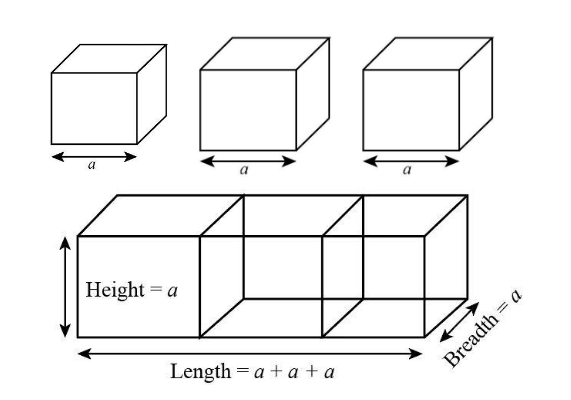Answer
405.9k+ views
Hint: The side of the cube is given in the question. With the help of the side of the cube, we will find the dimensions of the resulting cuboid. Then to find the surface area of the resulting cuboid,we will use the expression of the surface area of the cuboid. We will substitute the value of length, breadth and height in the expression of the surface area of the cuboid to get the final answer.
Complete step-by-step answer:
The surface area of the cuboid is expressed as:
$ S{\text{urface area of cuboid}} = 2\left( {lb + bh + hl} \right) $
Here $ l $ stand for length, $ b $ stands for breadth and $ h $ stands for height.
Step by step answer:
The side of the three cubes is $ {\text{4}}\;{\text{cm}} $ . It is given in question that we need to join three cubes. It can be shown as:

We can see that from the figure that after joining two cubes, one cuboid will fotext whose side can be expressed as
The length of the cuboid is:
$ \begin{array}{l}
l = a + a + a\\
l = 4\;{\text{cm}} + 4\;{\text{cm}} + 4\;{\text{cm}}\\
l = 12\;{\text{cm}}
\end{array} $
The breadth of the cuboid is $ b = a = 4\;{\text{cm}} $
The height of the cuboid is $ h = a = 4\;{\text{cm}} $
We know that the surface area of the cuboid can be expressed as
$ S{\text{urface area of cuboid}} = 2\left( {lb + bh + hl} \right) $
We will substitute $ 12\;{\text{cm}} $ for $ l $ , $ 4\;{\text{cm}} $ for $ b $ and $ 4\;{\text{cm}} $ for $ h $ in the above expression, we will get
$ \begin{array}{l}
S{\text{urface area of cuboid}} = 2\left( {\left( {12\;{\text{cm}}} \right)\left( {4\;{\text{cm}}} \right) + \left( {4\;{\text{cm}}} \right)\left( {4\;{\text{cm}}} \right) + \left( {4\;{\text{cm}}} \right)\left( {4\;{\text{cm}}} \right)} \right)\\
S{\text{urface area of cuboid}} = 2\left( {48\;{\text{c}}{{\text{m}}^2} + 16\;{\text{c}}{{\text{m}}^2} + 32\;{\text{c}}{{\text{m}}^2}} \right)\\
S{\text{urface area of cuboid}} = 2\left( {96\;{\text{c}}{{\text{m}}^2}} \right)\\
S{\text{urface area of cuboid}} = 192\;{\text{c}}{{\text{m}}^2}
\end{array} $
Hence the surface area of the resulting cuboid is $ {\text{192}}\;{\text{c}}{{\text{m}}^{\text{2}}} $ .
Note: Whenever we join three cubes, a new cuboid is fotexted such that the volume never changes but the surface area always changes. The volume of the three cubes joined will always be equal to the volume of the cuboid. But we need to calculate the surface area as it always changes.
Complete step-by-step answer:
The surface area of the cuboid is expressed as:
$ S{\text{urface area of cuboid}} = 2\left( {lb + bh + hl} \right) $
Here $ l $ stand for length, $ b $ stands for breadth and $ h $ stands for height.
Step by step answer:
The side of the three cubes is $ {\text{4}}\;{\text{cm}} $ . It is given in question that we need to join three cubes. It can be shown as:

We can see that from the figure that after joining two cubes, one cuboid will fotext whose side can be expressed as
The length of the cuboid is:
$ \begin{array}{l}
l = a + a + a\\
l = 4\;{\text{cm}} + 4\;{\text{cm}} + 4\;{\text{cm}}\\
l = 12\;{\text{cm}}
\end{array} $
The breadth of the cuboid is $ b = a = 4\;{\text{cm}} $
The height of the cuboid is $ h = a = 4\;{\text{cm}} $
We know that the surface area of the cuboid can be expressed as
$ S{\text{urface area of cuboid}} = 2\left( {lb + bh + hl} \right) $
We will substitute $ 12\;{\text{cm}} $ for $ l $ , $ 4\;{\text{cm}} $ for $ b $ and $ 4\;{\text{cm}} $ for $ h $ in the above expression, we will get
$ \begin{array}{l}
S{\text{urface area of cuboid}} = 2\left( {\left( {12\;{\text{cm}}} \right)\left( {4\;{\text{cm}}} \right) + \left( {4\;{\text{cm}}} \right)\left( {4\;{\text{cm}}} \right) + \left( {4\;{\text{cm}}} \right)\left( {4\;{\text{cm}}} \right)} \right)\\
S{\text{urface area of cuboid}} = 2\left( {48\;{\text{c}}{{\text{m}}^2} + 16\;{\text{c}}{{\text{m}}^2} + 32\;{\text{c}}{{\text{m}}^2}} \right)\\
S{\text{urface area of cuboid}} = 2\left( {96\;{\text{c}}{{\text{m}}^2}} \right)\\
S{\text{urface area of cuboid}} = 192\;{\text{c}}{{\text{m}}^2}
\end{array} $
Hence the surface area of the resulting cuboid is $ {\text{192}}\;{\text{c}}{{\text{m}}^{\text{2}}} $ .
Note: Whenever we join three cubes, a new cuboid is fotexted such that the volume never changes but the surface area always changes. The volume of the three cubes joined will always be equal to the volume of the cuboid. But we need to calculate the surface area as it always changes.
Recently Updated Pages
The base of a right prism is a pentagon whose sides class 10 maths CBSE

A die is thrown Find the probability that the number class 10 maths CBSE

A mans age is six times the age of his son In six years class 10 maths CBSE

A started a business with Rs 21000 and is joined afterwards class 10 maths CBSE

Aasifbhai bought a refrigerator at Rs 10000 After some class 10 maths CBSE

Give a brief history of the mathematician Pythagoras class 10 maths CBSE

Trending doubts
Difference Between Plant Cell and Animal Cell

Give 10 examples for herbs , shrubs , climbers , creepers

Difference between Prokaryotic cell and Eukaryotic class 11 biology CBSE

Fill the blanks with the suitable prepositions 1 The class 9 english CBSE

Name 10 Living and Non living things class 9 biology CBSE

Change the following sentences into negative and interrogative class 10 english CBSE

Fill the blanks with proper collective nouns 1 A of class 10 english CBSE

Select the word that is correctly spelled a Twelveth class 10 english CBSE

Write the 6 fundamental rights of India and explain in detail



